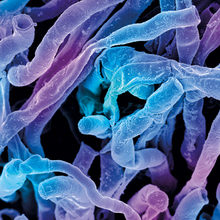Editorial
Issue: What is life?
10 May 2016 article

Grappling with the question ‘What is life?’ is not for the fainthearted. Reaching a consensus, even within the scientific community, is both a challenge and an aspiration. However, as a community of scientists, it is apparent that microbiologists are extremely well placed to influence the debate.
As technological and scientific advances push forward our knowledge boundaries, the answer to ‘What is life?’ is becoming tantalisingly closer. As I have learnt during my tenure at the Norwich Medical School, scientists are not the only voices grappling with this question.
Ethicists, the legal community and different religious communities to name a few continue to debate this issue as scientists continue to advance the meaning of life and living as technology and scientific advances continue to progress. Very recently, researchers working with Craig Venter published a report in Science describing a bacterium, Syn 3.0, that has been engineered to have the smallest genome of any freely living organism. Its genome has been pared down to the bare essentials; just 473 genes are needed to survive and reproduce. The evidence that is coming through seems to suggest that it is becoming more and more unlikely that ‘The answer to the ultimate question of life, the universe and everything is going to be 42’. So far the evidence is pointing to 473.
The first article asks the question ‘Are viruses alive?’ Clearly, viruses have shaped history. Viruses by their very nature challenge our understanding of what it means to be alive, and this question has been at the heart of an ongoing debate that has been around for more than a century. Different sides of the argument are presented by David Bhella and Nigel Brown.
John Ward writes our next article. He describes how astromicrobiology is perfectly placed to ask (and answer) whether there is life on Mars. Looking at microbial life forms that can survive and thrive in extreme environments on Earth is providing scientists with clues about the possibility and viability of life on our neighbouring planet.
The role of scientists in the ‘What is life?’ debate is evolving too. Sarah Richardson and Nicola Patron have co-authored an article that describes how synthetic biology is opening up new opportunities to manipulate, transplant and create new organisms. They also describe why scientific advances cannot take place in a vacuum but require a complete package of intellectual property assessment, ethical debate and philosophical review.
Next, Martin Embley and Tom Williams describe how new models based on molecular sequencing and metagenomics analysis using environmental DNA samples challenge the traditional three-domain tree of life. The new model supports two domains instead of three, with eukaryotes originating from a common prokaryotic ancestor shared with Archaea. To coincide with the Molecular Biology of Archaea Focused Meeting to be held in London later this year, Hannah Marriott and Thorsten Allers pick up the Archaea story. They describe how this brand new domain of life contains more than an exotic group of extremophiles. In fact this ‘newest’ domain of life is one of the most ancient and ubiquitous. Our previous conceptions of archaeal life continue to be challenged as scientists continue to find new lineages.
Finally, Adam Staines from the BBSRC has written the Comment article. It focuses on one of the most important issues to occupy scientists’ minds after the meaning of life question: what are the policies that underpin funding for research?
As our knowledge about the microbial world continues to expand, my money is on microbiologists finding the answer to the question ‘What is life?’ and also where did it begin?
LAURA BOWATER
Editor
[email protected]
Image: Coloured scanning electron micrograph of strands of Actinomyces viscosus. Science Photo Library..
